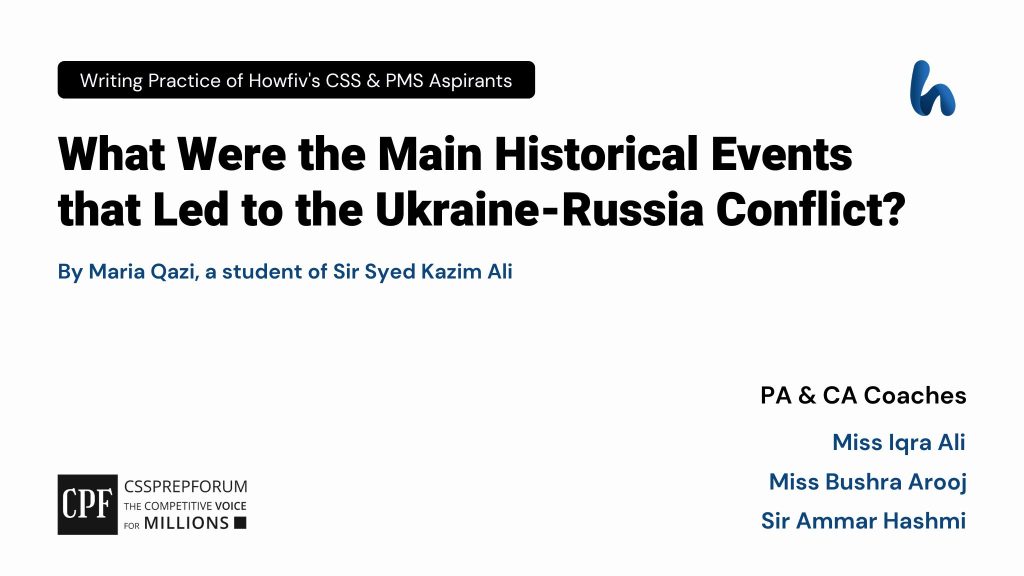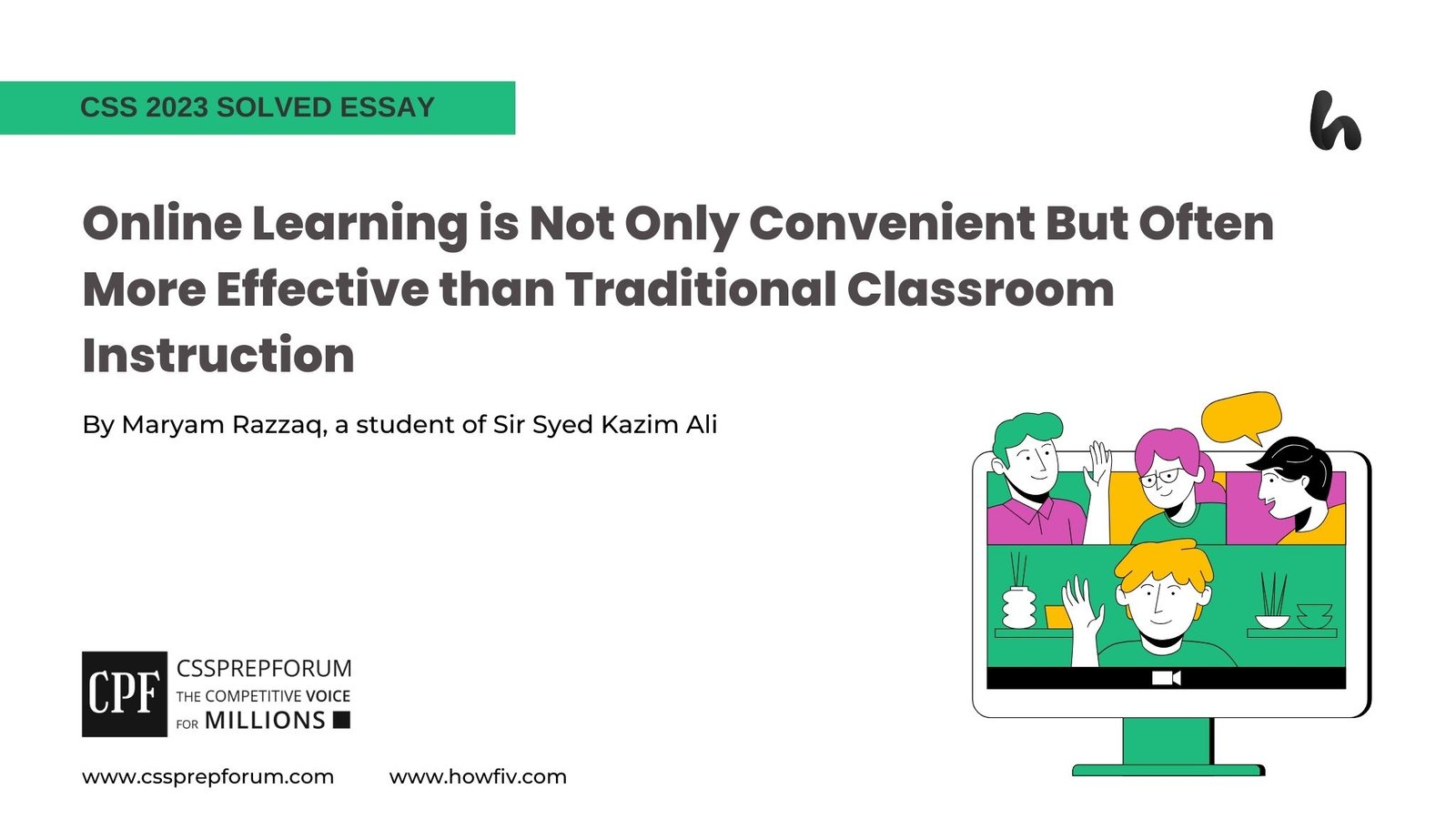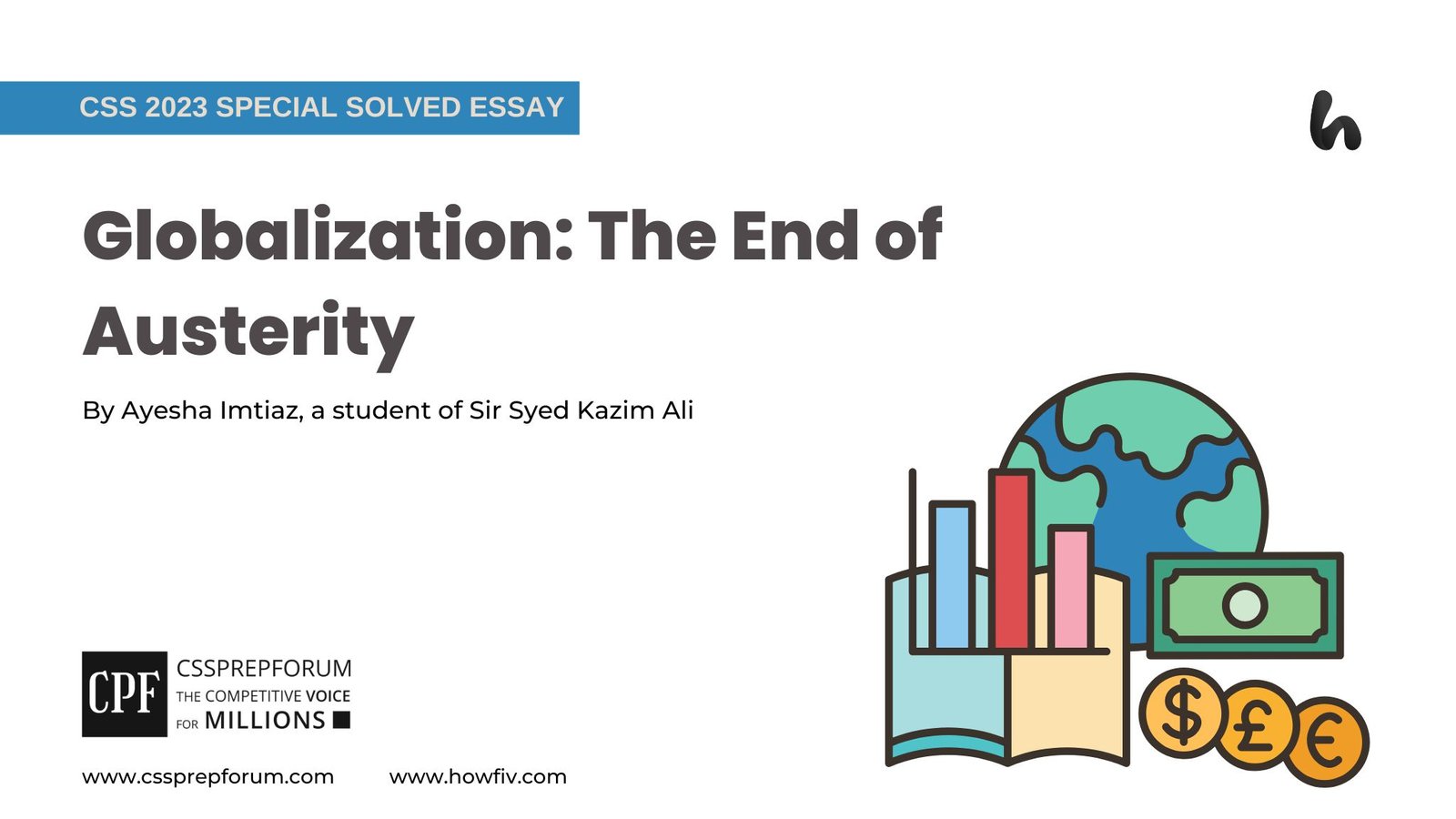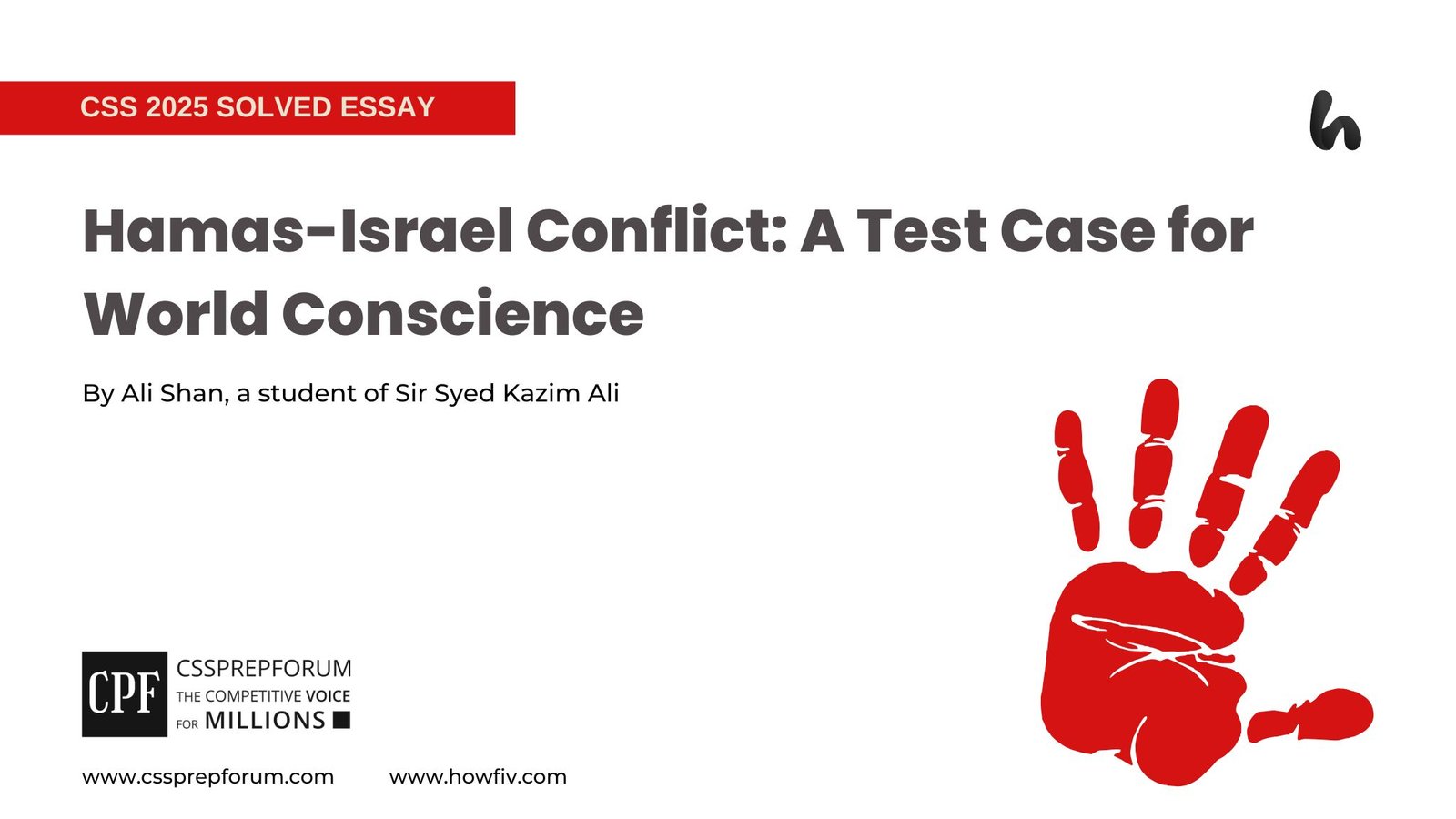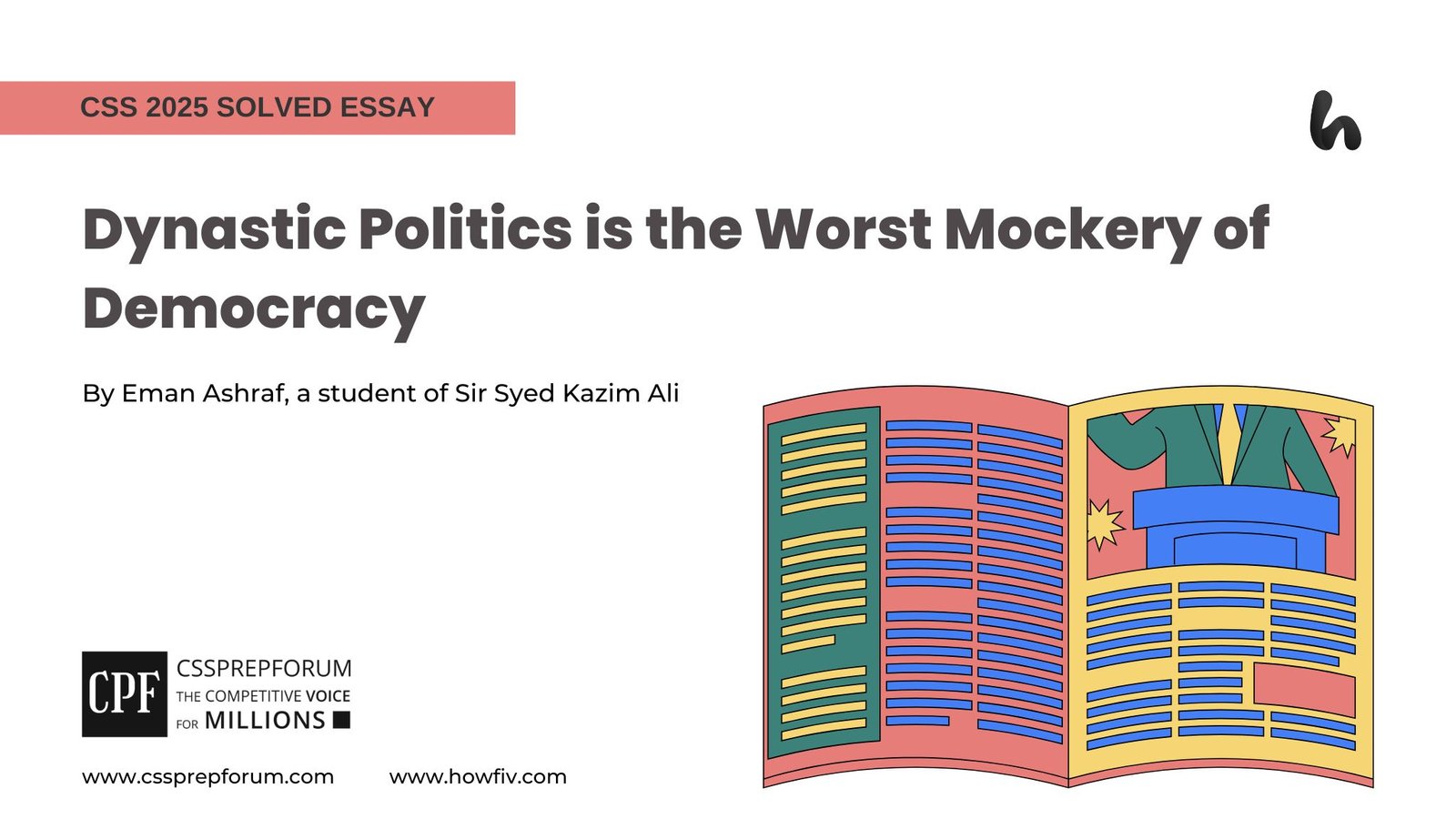CSS Current Affairs | History of the Russia-Ukraine Conflict
The following question of CSS Current Affairs is solved by Maria Qazi under the supervision of Howfiv’s Pakistan Affairs and Current Affairs Coaches. She learnt how to attempt 20 marks question and essay writing from Sir Syed Kazim Ali, Pakistan’s best CSS and PMS English essay and precis teacher with the highest success rate of his students. This solved past paper question is attempted on the pattern taught by Sir to his students, scoring the highest marks in compulsory and optional subjects for years, and uploaded to help aspirants understand how to crack a topic or question, how to write relevantly, what coherence is, and how to include and connect ideas, opinions, and suggestions to score the maximum.

Outline
1-Introduction
2-Understanding Ukraine – Russia Conflicts
3-Current Scenario of the Conflict
4-Strategic historical events leading up to the Russia – Ukraine War
- ✓Accession of Ukraine to the Treaty of Non-Proliferation of Nuclear Weapons in 1994
- ✓NATO Summit extending a (MAP) plan to Ukraine in 2008
- ✓Ukraine-European Union Association Agreement in 2012
- ✓Euromaidan Revolution 21st Nov 2013
- ✓Ousting Pro-Russian President in Ukraine 22 Feb 2014
- ✓Annexation of Crimea by Russia 26th Feb to 21st March 2014
- ✓Russian separatists movements in Donbass 12th April 2014
5-Conclusion

Answer to the Question
Introduction
The aftermath of the conflict between nations not only annihilates the peace and security of the nations in war but also resurrects economic, social, and political tensions worldwide by halting the advancement of trade and investment, political unity, and social progress. The current financial crisis, inflation, political instability, assassination of political leaders, and social chaos the world faces today are glaring examples of the consequences of the regional wars in Asia, Middle-East and African countries. Similarly, the instability unleashed by the Russia-Ukraine conflict has also shocked the world. However, the conflict was initially fueled by NATO due to the deployment of its forces close to Russian borders and shifting Ukraine’s economic and political ties from Russia to the EU nations, threatening Russia’s territorial and national interests. However, after ousting the pro-Russia president from Ukraine and protests from pro-Russians against the incoming pro-West president in Ukraine, Russia decides to invade Crimea. While discussing the Crimea situation with security chiefs, Russian President Vladimir Putin remarked, “We must start working on returning Crimea to Russia”. The invasion became successful quickly and led to further annexation until 2024 amid warnings, sanctions, and political pressure from the EU countries and the West. As a result, both countries faced enormous economic losses, including a fall in GDP, freezing accounts, and damaged infrastructure. Surprisingly, Ukraine’s membership in NATO remains a dream. To conclude, the unsuitable and indispensable interference of NATO in Russia-Ukraine relations has escalated a long-lasting war between both nations, leading to economic, political, and humanitarian crises.
Understanding Ukraine – Russia Conflicts
However, before exploring the events that led to the Russia-Ukraine War, it is imperative to understand the Russia-Ukraine relationship, which went through significant phases from a brotherly relationship to a stained one and then moved towards intense war. Throughout history, both nations have shared a common language, culture, and religion with common political and economic interests. Ukraine hosted more than eight million Russians, nearly 17% of its majority, in its land. Ukrainians accounted for six per cent of Russia’s majority. Economically, the EU fulfilled 30 per cent of Russia’s economic interest through 2 prominent gas pipelines installed in Ukraine. In comparison, 70 percent of Ukraine’s gas and oil were derived from Russia at almost zero cost, making Ukraine highly dependent on Russia for its natural resources. Unfortunately, the relationship between the nations rusted due to unsuitable and inappropriate interference of the EU and NATO in converging Ukraine’s national interests towards Europe, imparting a severe threat to Russia’s national interest, especially that of its economy. Moreover, by making Russia’s neighbouring countries its allies, granting them NATO membership and moving forces towards eastern Russian borders, NATO contiguously threatened Russia’s sovereignty, given what Russia felt for a retaliatory response once and all, as it cannot afford armed forces 32 nations across its borders. Thus, the war emerged and resulted in sanctions, economic loss, invasion, killings and the fleeing of millions.
Current Scenario of the Conflict
Currently, as the ten years of the Russia-Ukraine brutal War advances, Russia has invaded almost 17 per cent of Ukraine’s territory, followed by sanctions and economic and human capital loss. Recently, Russian troops significantly advanced north and northeast of Kharkiv, Ukraine’s second-largest city, and east towns of Avdiivka and Bakhmut. Economically, Ukraine’s economic output is only at a fraction of its pre-war levels, having $152 billion in damage and falling in GDP by almost 30 per cent. Similarly, during the war, the EU faced disrupted trade, high inflation, and a 1.6 GDP loss of Euros 175 billion. On the other side, intensive economic sanctions imposed on Russia by the EU, the West, G7 countries, and Australia paralyzed Russia’s economy, making it unable to finance war. Meanwhile, only 3 per cent of Russia’s economy is accounted for by EU countries, which was 30 per cent before the war. Surprisingly, the NATO membership of Ukraine remained undone even in its ten years of war.
Strategic historical events leading up to the Russia – Ukraine War
Following are the significant historical events that led to the Russia-Ukraine War, initiated by NATO’s hostile approach towards Russia and led to Crimea’s annexation by Russia until the present ongoing war.
- Accession of Ukraine to the Treaty of Non-Proliferation of Nuclear Weapons in 1994
Most significantly, on 5 Dec 1994, a political agreement known as The Budapest Memorandum on Security Assurances was signed at the Organization for Security and Co-operation (OSCE) in Europe, aiming to access Ukraine to the Treaty of Non-Proliferation of Nuclear Weapons (NPT). According to the agreement, Ukraine, having the World’s third largest nuclear weapons, was to transfer all its nuclear weapons to the Russian Federation, making Ukraine a non-nuclear power, and the USA, the UK and Russia refrained from using nuclear weapons against NPT countries except in case of self-defence. Although the agreement honoured Ukraine’s sovereignty and its right to its territory and confirmed its recognition, the agreement made the country rely on the mercy of superpowers Russia and the USA. This reliance and imbalance of power in the region were the significant inducements behind Russia’s daredevil decision to dominate Ukraine.
- NATO Summit extending a (MAP) plan to Ukraine in 2008
Apart from that, the tension in the region intensified after NATO, an anti-Russia organization, made the Membership Action Plan (MAP) to extend NATO, welcoming Ukraine’s request to become a NATO member of the US. According to Article (5) in NATO’s charter, if a NATO ally or member becomes a victim of an armed attack, all 32 members of NATO consider the attack as an attack on them and have the responsibility to deploy their armies to support the victim. Since NATO continuously increases its military expansion towards eastern, close to Russia, and provides membership to neighbouring nations of Russia where Russia has its national interests, including trade through gas pipelines in Ukraine, Moscow considers the approach as a threat to Russian national interests. Following that _in March 2008, at the Bucharest Summit_ Ukraine and Georgia were summoned for membership in NATO, which was accepted by the US and rejected by European countries to avoid antagonising Russia. In response to that, the Russian President, Vladimir Putin, warned, “Moscow would view any attempt to expand NATO to its borders as a “direct threat”. However, the NATO leaders withstand their claim against Russia. Therefore, the Bucharest Summit 2008 was where the conflict seemed to emerge.
- Ukraine-European Union Association Agreement in 2012
Afterwards, the Ukraine-European Union Association Agreement in 2012, officially published on 15 May 2013, possessing sub-parts, has brought up another significant economic threat to Russia. The agreement would make Ukraine converge its economic, political, judicial, and legislative policies towards Europe rather than Russia. Whereas Russia’s two main natural gas export pipelines, named The Urengoy _ Pomary Uzhorod _ also known as the Brotherhood pipeline _ and the Soyuz _ known as the Union pipelines_ are operated and owned by Ukraine, holding a significant chunk of Russia’s economy. As marked by the UN COMTRADE database on international trade, European Union Imports from Russia were US$195.56 Billion in 2022. On the other hand, Russia accounts for nearly a quarter of Ukraine’s international trade economy. However, the economic part of the agreement (Ukraine-European Union Association Agreement title IV, V, VI) allows Ukraine to shift its monetary policies, including pipeline agreements, towards Europe and stop Russia from using them at the end of the Moscow_ Kyiv deal 2002-24, subjugating Russia’s economy. The agreement is a matter of life and death for Russia’s economy, which is obtained by Ukraine’s pipelines. In response to that, in a letter to Ukrainian President Petro Poroshenko, Putin warned that even changing national legislation to prepare for the EU-Ukraine trade deal, known as the association agreement, would trigger an immediate response from Moscow. Thus, the EU’s hostile approach and interference with Ukraine _and Russia’s economic ties have stained the brotherly relations of both nations.
- Euromaidan Revolution 21st Nov 2013
Moreover, the Euromaidan Revolution, a revolution against the pro-Russian president in Ukraine, has added fuel to the hostility between Russia and Ukraine. To elaborate, after the Pro-Russian president, Viktor Yanukovych, refused to sign the European-Ukrainian Association Agreement and decided to close ties with Russia, a wave of demonstrations and unrest started by the Pro-EU Ukrainians in Kiyv on 21st Nov 2013, leading up to internal war with the police against the government. During the uprising, several were killed, intense protest encircled Kiyv, and 20,000 marched from Maidan to the parliament to strip the president of crucial powers. As a result, the president was overthrown, and a Pro-EU NATO, Petro Poroshenko, was elected as the new president, threatening Russia’s national interests. Therefore, the Euromaidan Revolution, later named the Revolution of Dignity, sparked mistrust and hostility between both nations.
- Ousting Pro-Russian President in Ukraine on 22 Feb 2014
Following that, As a result of the Euromaidan Revolution or Revolution of Dignity, the Ukrainian parliament voted to remove the pro-Russia president in February 2014, which again signalled a threat to Russia’s national interests as the new elect was cleared to be anti-Russia and Pro-Western Prime Minister, Viktor Yushchenko. In response to that, on 22–23 February, Russian President Vladimir Putin called an all-night meeting with security staff to discuss the emancipation of the dismissed Ukrainian president, Viktor Yanukovych; at the end of the meeting, he emphasised work on returning Crimea to Russia to protect Russia’s not only economic interests but also its historical and religion norms.
- Annexation of Crimea by Russia 26th Feb to 21st March 2014
Within a short span, Russia deployed its armies along the borders of Crimea and annexed the region from 20th Feb 2014 to 21st March 2014. To illustrate, after the expulsion of the pro-Russian president, pro-Russian protests marched in Crimea against the incoming Ukrainian government, leading to a vacuum of power in the region. As a result, while discussing the Crimea situation with security chiefs, Russian President Vladimir Putin remarked, “We must start working on returning Crimea to Russia”. Next, on 27 Feb, Russian Special Forces were deployed in strategic sites of Crimea and seized the region; later, they occupied the Crimean parliament, dismissed it and installed Askyonov, the Pro-Russian government. Moreover, on 18th March 2014, the Russian President signed the accession treaty with Ukrainian leaders. This invasion significantly sparked the start of the Russia-Ukraine war.
- Russian separatists movements in Donbass 12th April 2014
Finally, in April 2014, the Russian separatists led by a Russian citizen and former Russian political prisoner in Ukraine, Igor Girkin, declared independence in the eastern region of Donbas with support from Russia, controlling the entire region. However, the annexation was declared illegal by Kyiv and the West. This annexation is the main phase of the Russia-Ukraine War, including the Russian invasion of Ukraine until 2022.
Conclusion
To Conclude, NATO’s hostile approach towards Russia in terms of deploying troops near Russian borders, offering Ukraine membership in NATO, and transferring Ukraine’s national interests towards the EU from Russia despite Russia’s constant warnings has escalated war between the nations in 2014. The war was initiated by the Crimean annexation and the Donbas invasion and control of Ukraine’s four major and significant cities. Further, it moved towards Ukraine’s north, northeast, and east regions, invading almost 17 per cent of the land. However, the war carried out catastrophic losses, including economic loss, infrastructure damage, flee of refugees in millions and thousands of killings. Moreover, the war led to inflation, economic crisis, and social and political injustice in European countries and the West. Nonetheless, despite sanctions and pressure from the West and EU on Russia and the strategic situation in Ukraine, neither the war stopped nor Ukraine got membership in NATO. Thus, the unsuitable and indispensable interference of NATO in Russia-Ukraine relations has escalated a long-lasting war between both nations, leading to economic, political, and humanitarian crises.

CSS Solved Past Papers’ Essays
Looking for the last ten years of CSS and PMS Solved Essays and want to know how Sir Kazim’s students write and score the highest marks in the essays’ papers? Then, click on the CSS Solved Essays to start reading them.
CSS Solved Essays
CSS Solved Islamiyat Past Papers
Want to read the last ten years’ Islamiyat Solved Past Papers to learn how to attempt them and to score high? Let’s click on the link below to read them all freely. All past papers have been solved by Pakistan’s top CSS Islamiyat coach having the highest score of their students.
CSS Solved Islamiyat
CSS Solved General Science & Ability Past Papers
Want to read the last ten years’ General Science & Ability Solved Past Papers to learn how to attempt them and to score high? Let’s click on the link below to read them all freely. All past papers have been solved by Pakistan’s top CSS GSA coach having the highest score of their students.
CSS Solved General Science & Ability

